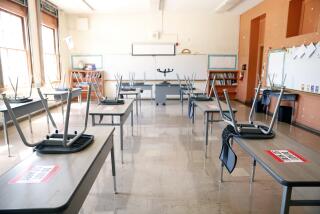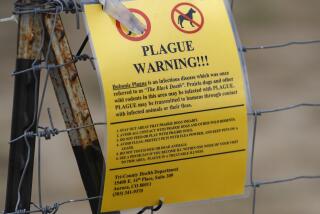Lesson Turns a School Day Into Knights
- Share via
Occasionally letting out a feeble moan, Brian Tebbets squirmed and twitched on his death bed. His sores were ghastly. Blood seeped through the festering wounds covering his face, hands and legs.
Using a tattered rag, a monk dabbed the 13-year-old’s head with water to ease his suffering.
“I’m trying to heal him up and make him feel better so he won’t concentrate on the pain,” explained 12-year-old Oliver Abbas.
While Brian, Oliver and a few of their seventh-grade classmates at Balboa Middle School used fake blood and wounds to reenact the not-so-pleasant aspects of the Middle Ages--such as the effects of the bubonic plague--the rest of their peers concentrated Tuesday on educating students about those olden days with lighter fare.
As part of a “live” Middle Ages history project, seventh-graders set up nine booths to enlighten sixth-graders on everything from the type of armor medieval people wore to the types of stained glass windows they formed.
“I think it makes us learn more because it’s more alive and stuff,” said 13-year-old Dyani Brunner, sitting across the room from the bubonic plague booth, busy fashioning medieval headdresses made of sparkling stars and arrays of colored ribbons. “It makes you feel like you’re really there.”
In addition to being dazzled by the new-found knowledge, “we get to miss two class periods,” seventh-grader Devin Toohey said with a smile.
Before students visited the rest of the booths, they checked in at the first desk, where a student wearing a jester’s hat hollered, “Passports, pull out your passports.” Using long white feathers, students signed their names on their pretend passports, using a mixture of blueberry and strawberry jam as ink. Those two berries, the jester explained, were commonly used as ink in the Middle Ages.
About a week ago, teacher Beth Pallares decided she wanted to teach the Middle Ages a bit differently this year.
“I get just as bored as the kids,” said Pallares, clad in a purple robe and a cone-shaped princess hat. “If they can explain the [subject] to someone else, you know they understand it.”
Every three minutes, she rang a bell, signaling the sixth-grade students to rotate to the next booth. At the bubonic plague booth, make-up artist Dane Elcar, 13, brushed a dash of gray eye shadow on the wounds of his fellow classmates. The wounds are supposed to look red on the rims and black on the inside, “sort of like a gigantic pimple that forms,” he explained.
As the next group of students headed toward the booth for a taste of the plague, he issued a warning: “Quick you guys, play dead.”






